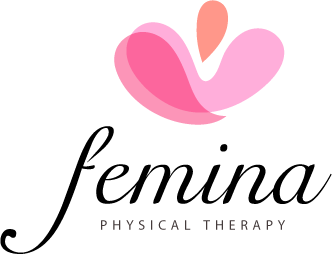Yoga Poses to Ease Pelvic Pain
Also Effective for Endometriosis Pain
1 in 10 women have endometriosis and experience different forms of pain—pain with urination, pain with bowel movements, painful periods, pelvic pain, ovulation pain, painful sex, abdominal pain, and nerve pain. The Office on Women’s Health of the U.S. Department of Health and Human Services estimates 5 million American women are affected by endometriosis.
As we covered in a previous blog post, endometriosis is a condition where endometrial-like tissue grows outside of the uterus (endometrial tissue is tissue that usually tissu grows inside of the uterus). Endometrial-like tissue can implant on the surface of organs and structures including the ovaries, bladder, rectum, and along the walls of the abdomen and pelvis. These tissues can cause inflammation and pain to develop throughout the abdomen and pelvic cavity.
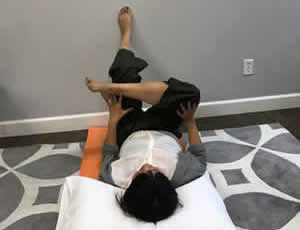
As a pelvic floor therapist and a registered yoga teacher, I have seen the power of gentle yoga poses to help stretch and lengthen the muscles and tissues in the abdomen, pelvis, low back, and hips during painful flareups.
Yoga poses to try if you are dealing with endo-related pain
What you will need:
- Pants you can stretch in
- An empty wall
- Yoga mat or folded blanket, rug, etc. for padding
- A pillow or bolster
1. Deep Breathing
Dealing with chronic pain often leads to the development of short and shallow breathing. Short and shallow breathing adds tension to the diaphragm, abdomen, and pelvic floor. Relearning how to breathe deeply is a profound way to start unraveling the tension inside the body, often held in between the ribs, in the low back, neck, shoulders, belly, and pelvic floor. Studies, such as this one by Roditi and Robinson (2011), also show that diaphragmatic breathing can help the body break the pain cycle, thereby reducing pain and chronic pain.
Deep breathing can be practiced anywhere: stuck in a traffic jam, waiting in line at the grocery store, or at night before you go to bed. Below are instructions for breathing on your back.
Instructions:
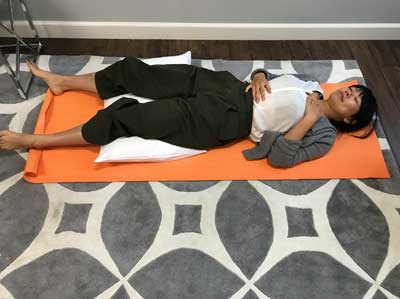
- Lay on your back. Knees can be bent with feet flat on the floor, or knees can be propped up on a pillow or bolster.
- Place one hand over the heart and one over the belly button.
- Inhale through the nose and feel both hands rise with the in-breath. Ribs are expanding, belly is also expanding, even the back of the body expands into the mat.
- Exhale gently and slowly, either through pursed lips or the nose. The air is slowly escaping as if you poked a hole in a tire with a needle and the air slowly passes out. The goal is to elongate the exhale, so that it is longer than the inhale.
- When the breath has been fully exhaled, pause for a second or two before beginning the breath cycle again, with another inhale. After you have exhaled wait a couple of seconds until you inhale again. Continue to breathing for 5-10 minutes.
2. Hamstring Stretch at the Wall
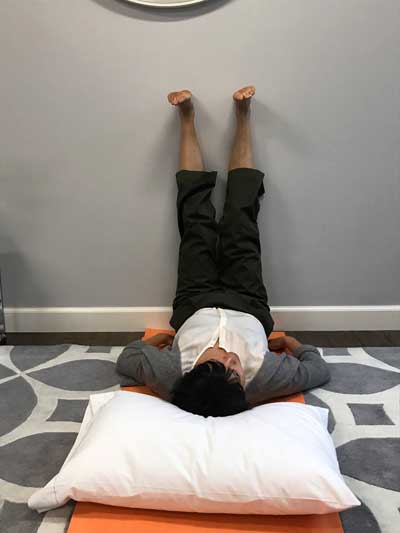
- Lay down comfortably on floor with both legs against the wall, feet towards the sky.
- Keep knees straight and pull toes down towards face
- Relax low back/pelvic and shoulders.
- Keep knee soft, NOT Locked.
- Keep your glutes and low back flat on floor.
- Breathe deeply throughout the stretch.
3. Adductor Stretch at the Wall
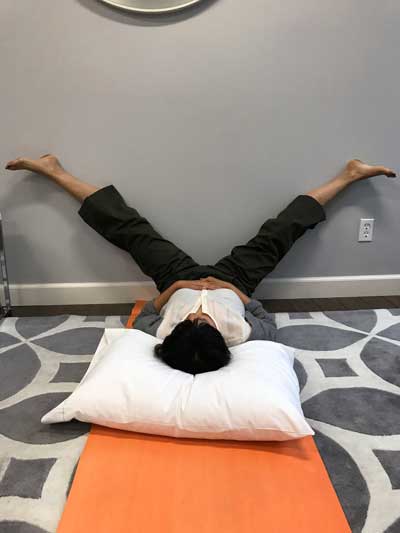
- Lay down comfortably on floor or bed with both legs on wall, as in the hamstring stretch (above).
- Rotate toes and hips outward and gently allow legs to slide out into a “V” shape.
- Relax low back and shoulders.
- Keep knee soft, NOT Locked.
- Keep your glutes and low back flat on floor.
- Breathe deeply throughout the stretch.
4. Hip & Buttock Stretch
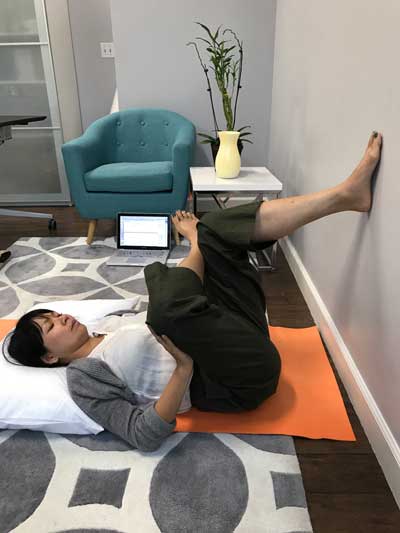

- Lay down comfortably on floor or bed with both legs on wall, as in the hamstring stretch (above).
- Place one ankle on opposite thigh.
- Slide opposite foot down wall until stretch is felt in hip/glute.
- Place gentle pressure with hand on knee (as seen in picture)
- Breathe deeply throughout the stretch.
5. Groin Stretch/Pelvic Floor Relax Position
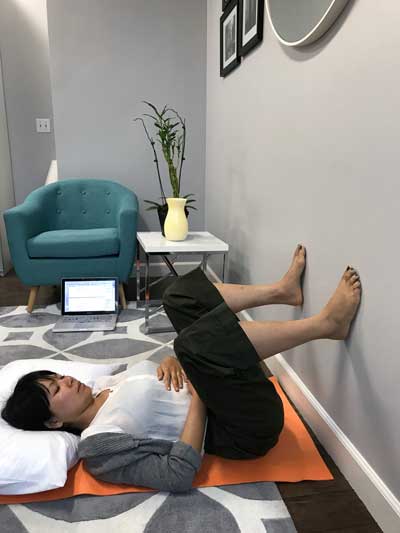
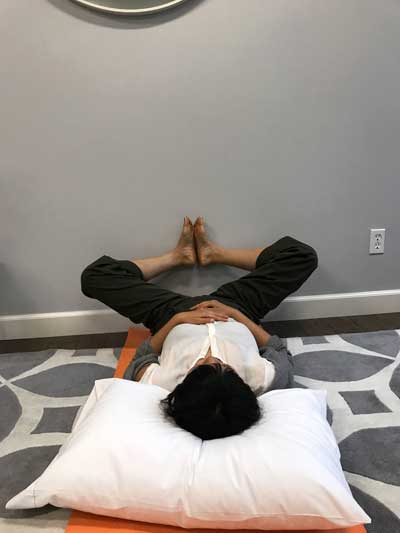
- Start in hamstring stretch position, bring knees to chest, feet flat on the wall.
- Do deep breathing and allow the pelvic floor muscles to sink into the mat, relaxing the muscles.
- You can rest here for 60 seconds, and focus on your deep breathing and pelvic floor relaxation.
6. Hip Flexor Stretch/Runner’s Lunge
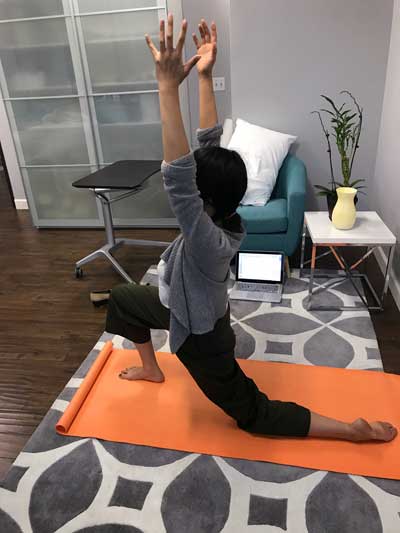
- Start in a kneeling position on a mat (you can have a towel or blanket under the knees)
- Step one foot forwards.
- Lean hip points forward, feeling a stretch down your quad in into the hip flexor.
- Maintain a neutral pelvic position.
- If you are feeling balanced, reach both arms towards the sky, spreading the collarbones towards the ceiling.
- You can rest here for 60 seconds, and focus on your deep breathing and pelvic floor relaxation.
7. Cobra Pose
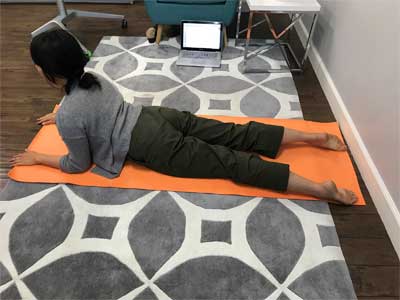
- Lie on your belly and spread your hands under the shoulders. Elbows hug in towards the body, in line with the nipples.
- Press the tops of the feet and thighs and the pelvis into the floor.
- On an inhalation, use arms to support you as you lift the chest off the floor. Do not go too high, 4-10 inches.
- Firm the glute muscles, without clenching the cheeks together. Bring the belly button to spine, engaging the low belly to support the low back.
- Breathe long and deeply for 1 minute.
8. Child’s Pose
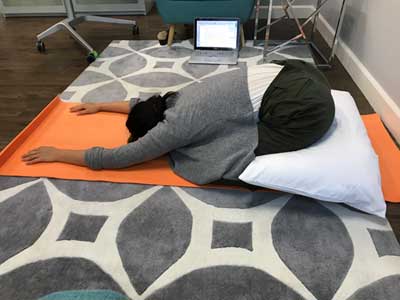
- Start on a quadraped (hands and knees) position
- Sit back on your heels and curl forwards bringing your forehead to the mat
- Reach your arms forward on the mat
- Try this position with a pillow or a bolster supporting the glutes and/or chest
- You can rest here for 60 seconds, and focus on your deep breathing and pelvic floor relaxation
For more great info on yoga poses to ease pelvic pain and other pelvic floor issues, subscribe to our newsletter here.



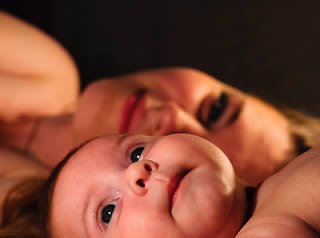




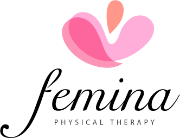
 Start Your Pelvic Health Journey
Start Your Pelvic Health Journey
